Abstract
The effect of circulating levels of plasma levodopa on reaction time performance was studied in patients with Parkinson's disease and untreated normal controls when instructed to move either a shorter or longer distance. On half the movements, subjects were pre-cued on the direction and amplitude of an impending movement. On the remaining movements, only the direction was pre-specified, and the amplitude was determined only when the cue to move was presented. Reaction time performance of patients was evaluated at three infusion levels of levodopa so that the patients were optimally, moderately, or minimally medicated. Parkinsonian patients were always slower to react and move than normal subjects. Clinical state correlated with movement time, but not with reaction time. These results contrast with those in which reaction time was related to plasma levodopa levels when movement direction and initiation were processed concomitantly, but the movement amplitude was pre-cued. It is possible that specification of the amount of muscle activity is partially independent of dopaminergic transmission.
Full text
PDF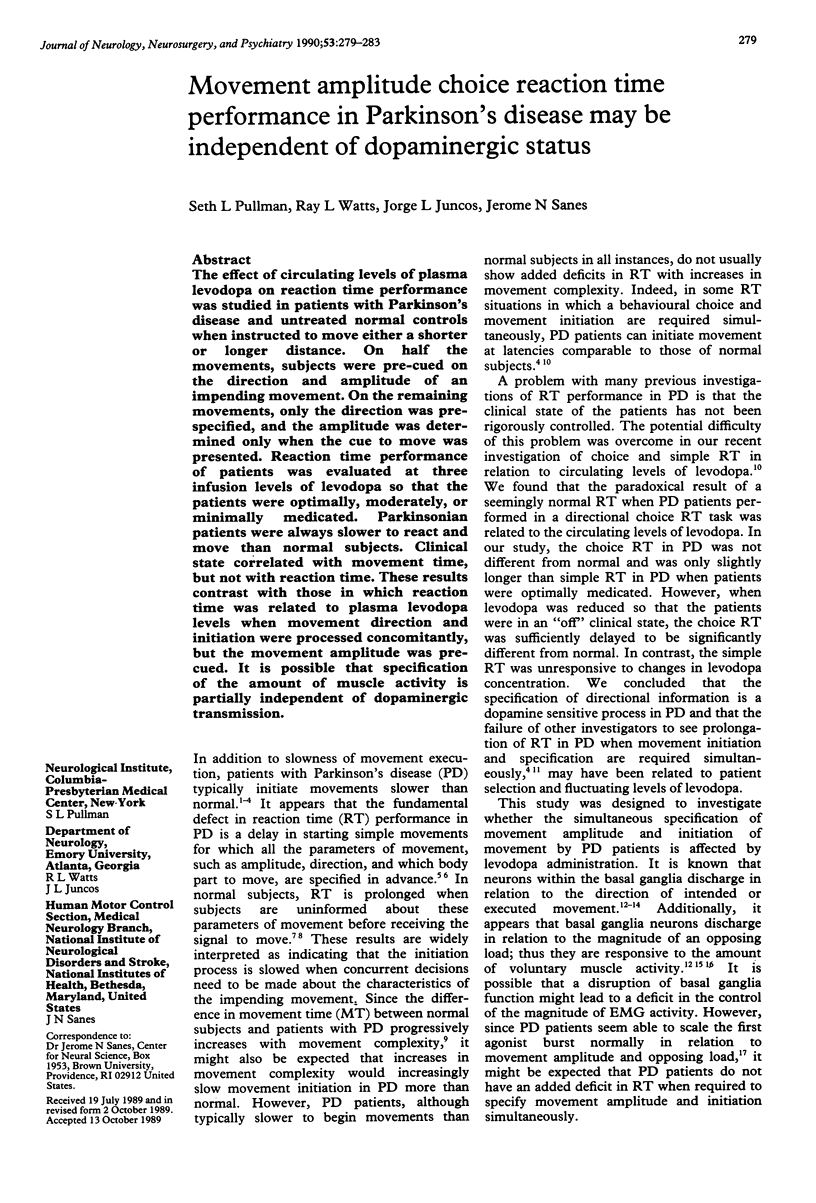
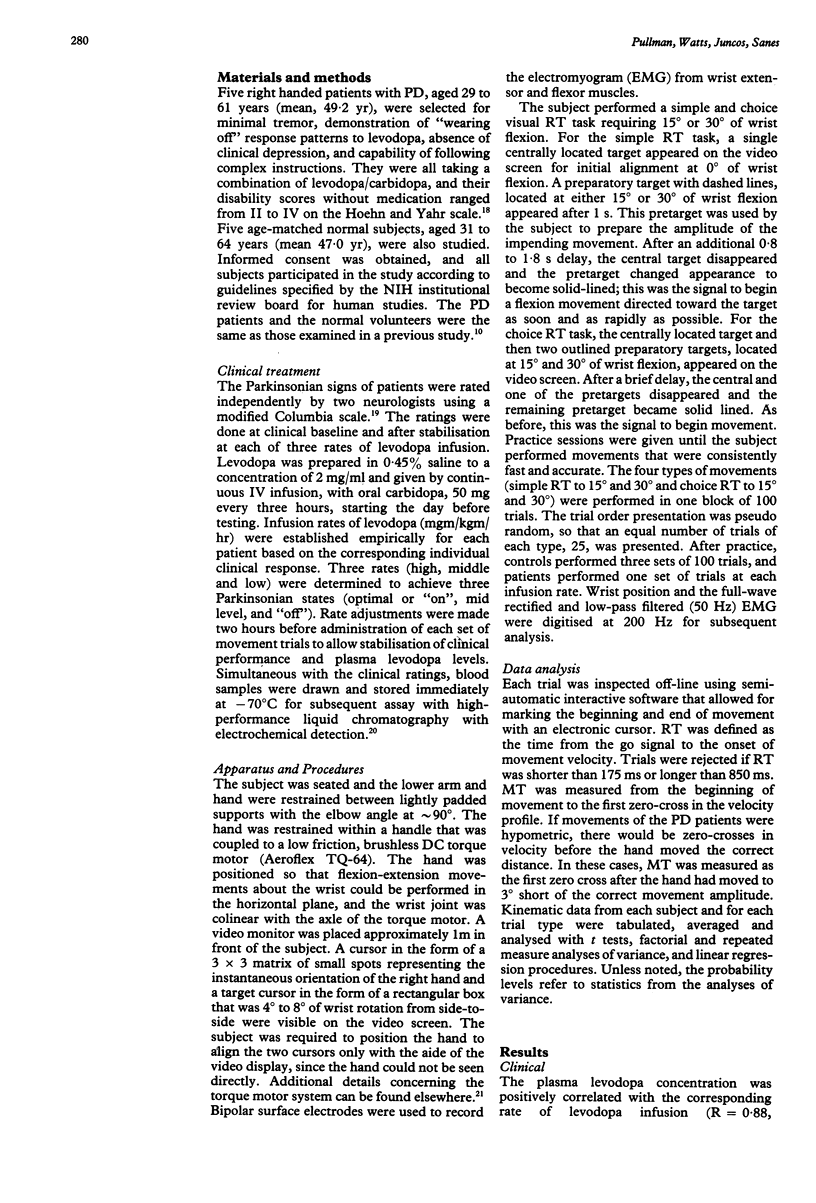
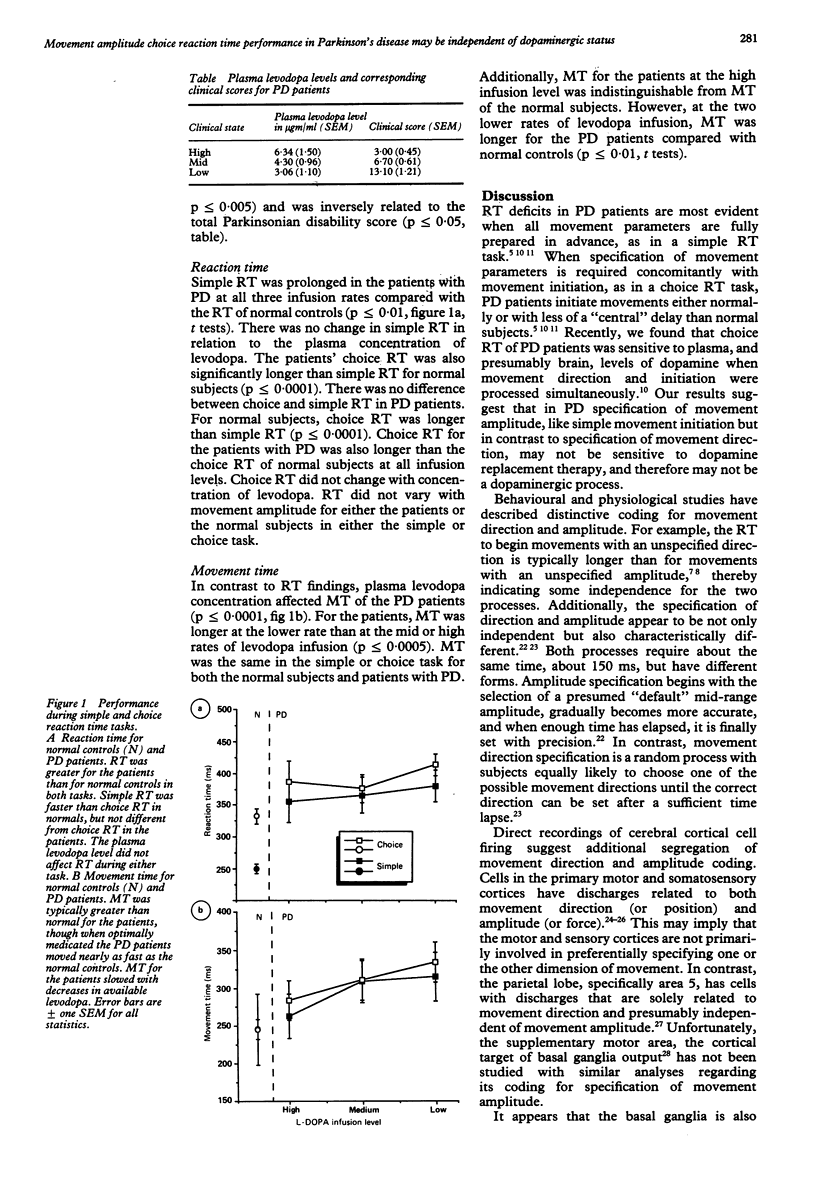
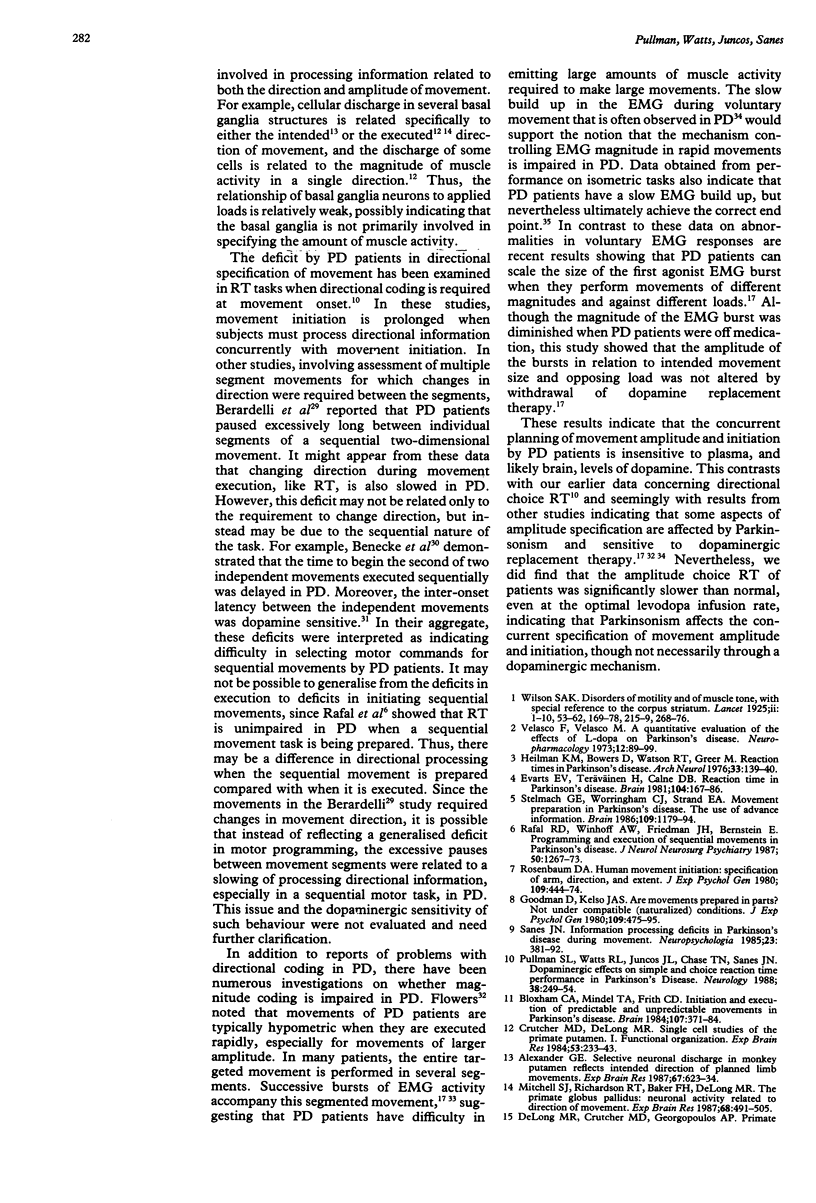
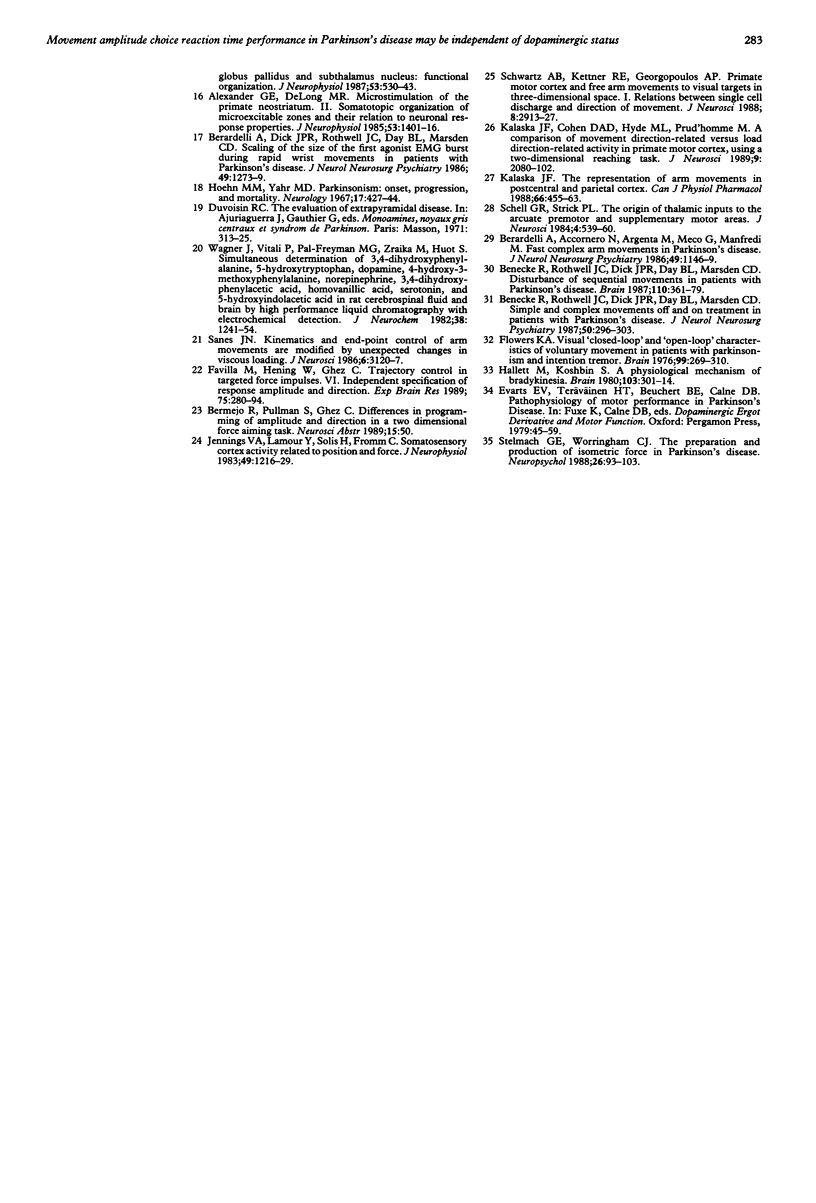
Selected References
These references are in PubMed. This may not be the complete list of references from this article.
- Alexander G. E., DeLong M. R. Microstimulation of the primate neostriatum. I. Physiological properties of striatal microexcitable zones. J Neurophysiol. 1985 Jun;53(6):1401–1416. doi: 10.1152/jn.1985.53.6.1401. [DOI] [PubMed] [Google Scholar]
- Alexander G. E. Selective neuronal discharge in monkey putamen reflects intended direction of planned limb movements. Exp Brain Res. 1987;67(3):623–634. doi: 10.1007/BF00247293. [DOI] [PubMed] [Google Scholar]
- Benecke R., Rothwell J. C., Dick J. P., Day B. L., Marsden C. D. Disturbance of sequential movements in patients with Parkinson's disease. Brain. 1987 Apr;110(Pt 2):361–379. doi: 10.1093/brain/110.2.361. [DOI] [PubMed] [Google Scholar]
- Benecke R., Rothwell J. C., Dick J. P., Day B. L., Marsden C. D. Simple and complex movements off and on treatment in patients with Parkinson's disease. J Neurol Neurosurg Psychiatry. 1987 Mar;50(3):296–303. doi: 10.1136/jnnp.50.3.296. [DOI] [PMC free article] [PubMed] [Google Scholar]
- Berardelli A., Accornero N., Argenta M., Meco G., Manfredi M. Fast complex arm movements in Parkinson's disease. J Neurol Neurosurg Psychiatry. 1986 Oct;49(10):1146–1149. doi: 10.1136/jnnp.49.10.1146. [DOI] [PMC free article] [PubMed] [Google Scholar]
- Berardelli A., Dick J. P., Rothwell J. C., Day B. L., Marsden C. D. Scaling of the size of the first agonist EMG burst during rapid wrist movements in patients with Parkinson's disease. J Neurol Neurosurg Psychiatry. 1986 Nov;49(11):1273–1279. doi: 10.1136/jnnp.49.11.1273. [DOI] [PMC free article] [PubMed] [Google Scholar]
- Bloxham C. A., Mindel T. A., Frith C. D. Initiation and execution of predictable and unpredictable movements in Parkinson's disease. Brain. 1984 Jun;107(Pt 2):371–384. doi: 10.1093/brain/107.2.371. [DOI] [PubMed] [Google Scholar]
- Crutcher M. D., DeLong M. R. Single cell studies of the primate putamen. I. Functional organization. Exp Brain Res. 1984;53(2):233–243. doi: 10.1007/BF00238153. [DOI] [PubMed] [Google Scholar]
- DeLong M. R., Crutcher M. D., Georgopoulos A. P. Primate globus pallidus and subthalamic nucleus: functional organization. J Neurophysiol. 1985 Feb;53(2):530–543. doi: 10.1152/jn.1985.53.2.530. [DOI] [PubMed] [Google Scholar]
- Evarts E. V., Teräväinen H., Calne D. B. Reaction time in Parkinson's disease. Brain. 1981 Mar;104(Pt 1):167–186. doi: 10.1093/brain/104.1.167. [DOI] [PubMed] [Google Scholar]
- Favilla M., Hening W., Ghez C. Trajectory control in targeted force impulses. VI. Independent specification of response amplitude and direction. Exp Brain Res. 1989;75(2):280–294. doi: 10.1007/BF00247934. [DOI] [PubMed] [Google Scholar]
- Flowers K. A. Visual "closed-loop" and "open-loop" characteristics of voluntary movement in patients with Parkinsonism and intention tremor. Brain. 1976 Jun;99(2):269–310. doi: 10.1093/brain/99.2.269. [DOI] [PubMed] [Google Scholar]
- Goodman D., Kelso J. A. Are movements prepared in parts? Not under compatible (naturalized) conditions. J Exp Psychol Gen. 1980 Dec;109(4):475–495. doi: 10.1037//0096-3445.109.4.475. [DOI] [PubMed] [Google Scholar]
- Hallett M., Khoshbin S. A physiological mechanism of bradykinesia. Brain. 1980 Jun;103(2):301–314. doi: 10.1093/brain/103.2.301. [DOI] [PubMed] [Google Scholar]
- Heilman K. M., Bowers D., Watson R. T., Greer M. Reaction times in Parkinson disease. Arch Neurol. 1976 Feb;33(2):139–140. doi: 10.1001/archneur.1976.00500020067011. [DOI] [PubMed] [Google Scholar]
- Hoehn M. M., Yahr M. D. Parkinsonism: onset, progression and mortality. Neurology. 1967 May;17(5):427–442. doi: 10.1212/wnl.17.5.427. [DOI] [PubMed] [Google Scholar]
- Jennings V. A., Lamour Y., Solis H., Fromm C. Somatosensory cortex activity related to position and force. J Neurophysiol. 1983 May;49(5):1216–1229. doi: 10.1152/jn.1983.49.5.1216. [DOI] [PubMed] [Google Scholar]
- Kalaska J. F., Cohen D. A., Hyde M. L., Prud'homme M. A comparison of movement direction-related versus load direction-related activity in primate motor cortex, using a two-dimensional reaching task. J Neurosci. 1989 Jun;9(6):2080–2102. doi: 10.1523/JNEUROSCI.09-06-02080.1989. [DOI] [PMC free article] [PubMed] [Google Scholar]
- Kalaska J. F. The representation of arm movements in postcentral and parietal cortex. Can J Physiol Pharmacol. 1988 Apr;66(4):455–463. doi: 10.1139/y88-075. [DOI] [PubMed] [Google Scholar]
- Mitchell S. J., Richardson R. T., Baker F. H., DeLong M. R. The primate globus pallidus: neuronal activity related to direction of movement. Exp Brain Res. 1987;68(3):491–505. doi: 10.1007/BF00249793. [DOI] [PubMed] [Google Scholar]
- Pullman S. L., Watts R. L., Juncos J. L., Chase T. N., Sanes J. N. Dopaminergic effects on simple and choice reaction time performance in Parkinson's disease. Neurology. 1988 Feb;38(2):249–254. doi: 10.1212/wnl.38.2.249. [DOI] [PubMed] [Google Scholar]
- Rafal R. D., Inhoff A. W., Friedman J. H., Bernstein E. Programming and execution of sequential movements in Parkinson's disease. J Neurol Neurosurg Psychiatry. 1987 Oct;50(10):1267–1273. doi: 10.1136/jnnp.50.10.1267. [DOI] [PMC free article] [PubMed] [Google Scholar]
- Rosenbaum D. A. Human movement initiation: specification of arm, direction, and extent. J Exp Psychol Gen. 1980 Dec;109(4):444–474. doi: 10.1037//0096-3445.109.4.444. [DOI] [PubMed] [Google Scholar]
- Sanes J. N. Information processing deficits in Parkinson's disease during movement. Neuropsychologia. 1985;23(3):381–392. doi: 10.1016/0028-3932(85)90024-7. [DOI] [PubMed] [Google Scholar]
- Sanes J. N. Kinematics and end-point control of arm movements are modified by unexpected changes in viscous loading. J Neurosci. 1986 Nov;6(11):3120–3127. doi: 10.1523/JNEUROSCI.06-11-03120.1986. [DOI] [PMC free article] [PubMed] [Google Scholar]
- Schell G. R., Strick P. L. The origin of thalamic inputs to the arcuate premotor and supplementary motor areas. J Neurosci. 1984 Feb;4(2):539–560. doi: 10.1523/JNEUROSCI.04-02-00539.1984. [DOI] [PMC free article] [PubMed] [Google Scholar]
- Schwartz A. B., Kettner R. E., Georgopoulos A. P. Primate motor cortex and free arm movements to visual targets in three-dimensional space. I. Relations between single cell discharge and direction of movement. J Neurosci. 1988 Aug;8(8):2913–2927. doi: 10.1523/JNEUROSCI.08-08-02913.1988. [DOI] [PMC free article] [PubMed] [Google Scholar]
- Stelmach G. E., Worringham C. J., Strand E. A. Movement preparation in Parkinson's disease. The use of advance information. Brain. 1986 Dec;109(Pt 6):1179–1194. doi: 10.1093/brain/109.6.1179. [DOI] [PubMed] [Google Scholar]
- Stelmach G. E., Worringham C. J. The preparation and production of isometric force in Parkinson's disease. Neuropsychologia. 1988;26(1):93–103. doi: 10.1016/0028-3932(88)90033-4. [DOI] [PubMed] [Google Scholar]
- Velasco F., Velasco M. A quantitative evaluation of the effects of L-dopa on Parkinson's disease. Neuropharmacology. 1973 Feb;12(2):89–99. doi: 10.1016/0028-3908(73)90079-8. [DOI] [PubMed] [Google Scholar]
- Wagner J., Vitali P., Palfreyman M. G., Zraika M., Huot S. Simultaneous determination of 3,4-dihydroxyphenylalanine, 5-hydroxytryptophan, dopamine, 4-hydroxy-3-methoxyphenylalanine, norepinephrine, 3,4-dihydroxyphenylacetic acid, homovanillic acid, serotonin, and 5-hydroxyindoleacetic acid in rat cerebrospinal fluid and brain by high-performance liquid chromatography with electrochemical detection. J Neurochem. 1982 May;38(5):1241–1254. doi: 10.1111/j.1471-4159.1982.tb07897.x. [DOI] [PubMed] [Google Scholar]


